Contribution of Infragravity Waves to Run-up and Overwash in the Pertuis Breton Embayment (France)
Abstract
:1. Introduction
1.1. Background
- Swash regime, where run-up is limited to the foreshore and any storm related erosion is recovered post-storm (net effect is zero);
- Collision regime, where the run-up exceeds the threshold of the base of the foredune ridge and is no longer confined to the foreshore area. The swash is then able to erode the dune (net erosion effect);
- Overwash regime, where the run-up overtops the berm or foredune ridge and a net landward transport of sediment occurs. This regime often results in washover deposits of sediment; and
- Inundation regime, where the combined effect of surge, tide and wave run-up is sufficient to completely and continuously submerge the beach or dune area.
1.2. Study Area
2. Methods
2.1. Field Experiment
2.2. Numerical Modeling
2.2.1. Hydrodynamic 2DH Model Setup
2.2.2. Morphodynamic 1D Model Setup
2.3. Data Analysis
2.3.1. Separation of Gravity and Infragravity Waves
2.3.2. Separation of Incoming and Outgoing Signals
2.4. Error Metrics
3. Results and Discussion
3.1. Wave Propagation Across the Embayment
3.2. Wave Run-up and Overwash of the Dune at La Faute-sur-Mer
4. Conclusions
Author Contributions
Funding
Acknowledgments
Conflicts of Interest
References
- Bertin, X.; Bakker, A.D.; Dongeren, A.V.; Coco, G.; Andre, G.; Ardhuin, F.; Bonneton, P.; Bouchette, F.; Castelle, B.; Craw, W.C. Infragravity Waves: From Driving Mechanisms to Impacts. Earth-Sci. Rev. 2018, 177, 774–799. [Google Scholar] [CrossRef]
- Sallenger, A.H. Storm Impact Scale for Barrier Islands. J. Coast. Res. 2000, 16, 890–895. [Google Scholar]
- Hunt, I.A. Design of Seawalls and Breakwaters. J. Waterw. Harb. Div. 1959, 85, 123–152. [Google Scholar]
- Holman, R.A. Extreme Value Statistics for Wave Run-up on a Natural Beach. Coast. Eng. 1986, 9, 527–544. [Google Scholar] [CrossRef]
- Hedges, T.S.; Mase, H. Modified Hunt’s Equation Incorporating Wave Setup. J. Waterw. Port Coast. Ocean Eng. 2004, 130, 109–113. [Google Scholar] [CrossRef]
- Stockdon, H.F.; Holman, R.A.; Howd, P.A.; Sallenger, A.H. Empirical Parameterization of Setup, Swash, and Runup. Coast. Eng. 2006, 53, 573–588. [Google Scholar] [CrossRef]
- Mather, A.; Stretch, D.; Garland, G. Predicting Extreme Wave Run-up on Natural Beaches for Coastal Planning and Management. Coast. Eng. J. 2011, 53, 87–109. [Google Scholar] [CrossRef]
- Soldini, L.; Antuono, M.; Brocchini, M. Numerical Modeling of the Influence of the Beach Profile on Wave Run-up. J. Waterw. Port Coast. Ocean Eng. 2013, 139, 61–71. [Google Scholar] [CrossRef]
- Park, H.; Cox, D.T. Empirical Wave Run-up Formula for Wave, Storm Surge and Berm Width. Coast. Eng. 2016, 115, 67–78. [Google Scholar] [CrossRef]
- Mayer, R.; Kriebel, D. Wave Run-up on Composite-slope and Concave Beaches. Coast. Eng. 1994, 1, 2325–2339. [Google Scholar]
- Shand, R.D.; Shand, T.D.; McComb, P.J.; Johnson, D.L. Evaluation of Empirical Predictors of Extreme Run-up Using Field Data. In Coasts and Ports 2011: Diverse and Developing: Proceedings of the 20th Australasian Coastal and Ocean Engineering Conference and the 13th Australasian Port and Harbour Conference; Engineers Australia: Barton, Australia, 2011; p. 669. [Google Scholar]
- Power, H.E.; Atkinson, A.L.; Hammond, T.; Baldock, T.E. Accuracy of Wave Run-up Formula on Contrasting Southeast Australian Beaches. In Coasts and Ports 2013: 21st Australasian Coastal and Ocean Engineering Conference and the 14th Australasian Port and Harbour Conference; Engineers Australia: Barton, Australia, 2013; pp. 1–6. [Google Scholar]
- Stockdon, H.F.; Thompson, D.M.; Plant, N.G.; Long, J.W. Evaluation of Wave Run-up Predictions from Numerical and Parametric Models. Coast. Eng. 2014, 92, 1–11. [Google Scholar] [CrossRef]
- Roelvink, D.; Reniers, A.; Dongeren, A.V.; De Vries, J.V.T.; Mccall, R.; Lescinski, J. Modeling Storm Impacts on Beaches, Dunes and Barrier Islands. Coast. Eng. 2009, 56, 1133–1152. [Google Scholar] [CrossRef]
- Bellotti, G.; Archetti, R.; Brocchini, M. Experimental Validation and Characterization of Mean Swash Zone Boundary Conditions. J. Geophys. Res. Oceans. 2003, 108, 3250. [Google Scholar] [CrossRef]
- Van Santen, R.; Steetzel, H.; De Vries, J.V.T.; Van Dongeren, A. Modeling Storm Impact on Complex Coastlines. Westkapelle, The Netherlands. Coast. Eng. Proc. 2012, 1, 52. [Google Scholar] [CrossRef]
- Grzegorzewski, A.S.; Johnson, B.D.; Wamsley, T.V.; Rosati, J.D. Sediment Transport and Morphology Modeling of Ship Island, Mississippi, USA, During Storm Events. Coast. Dyn. 2013, 1505–1516. [Google Scholar]
- Van Dongeren, A.; Lowe, R.; Trang, D.M.; Roelvink, D.; Symonds, G.; Ranasinghe, R. Numerical Modeling of Low-frequency Wave Dynamics over a Fringing Coral Reef. Coast. Eng. 2013, 73, 178–190. [Google Scholar] [CrossRef]
- McCall, R.T.; Masselink, G.; Poate, T.G.; Roelvink, J.A.; Almeida, L.P. Modeling the Morphodynamics of Gravel Beaches During Storms with Xbeach-g. Coast. Eng. 2015, 103, 52–66. [Google Scholar] [CrossRef]
- Bertin, X.; Olabarrieta, M. Relevance of Infragravity Waves in a Wave-dominated Inlet. J. Geophys. Res. Oceans 2016, 121, 5418–5435. [Google Scholar] [CrossRef]
- Lashley, C.H.; Roelvink, D.; Van Dongeren, A.; Buckley, M.L.; Lowe, R.J. Nonhydrostatic and Surfbeat Model Predictions of Extreme Wave Run-up in Fringing Reef Environments. Coast. Eng. 2018, 137, 11–27. [Google Scholar] [CrossRef]
- Breilh, J.-F.; Bertin, X.; Chaumillon, E.; Giloy, N.; Sauzeau, T. How Frequent is Storm-induced Flooding in the Central Part of the Bay of Biscay? Glob. Planet. Chang. 2014, 122, 161–175. [Google Scholar] [CrossRef]
- Nicolle, A.; Karpytchev, M. Evidence for Spatially Variable Friction from Tidal Amplification and Asymmetry in the Pertuis Breton (France). Cont. Shelf Res. 2007, 27, 2346–2356. [Google Scholar] [CrossRef]
- Bertin, X.; Li, K.; Roland, A.; Bidlot, J.-R. The Contribution of Short-waves in Storm Surges: Two Case Studies in the Bay of Biscay. Cont. Shelf Res. 2015, 96, 1–15. [Google Scholar] [CrossRef]
- Lumbroso, D.M.; Vinet, F. A Comparison of the Causes, Effects and Aftermaths of the Coastal Flooding of England in 1953 and France in 2010. Nat. Hazards Earth Syst. Sci. 2011, 11, 2321–2333. [Google Scholar] [CrossRef]
- Roelvink, D.; McCall, R.; Mehvar, S.; Nederhoff, K.; Dastgheib, A. Improving Predictions of Swash Dynamics in Xbeach: The Role of Groupiness and Incident-band Runup. Coast. Eng. 2018, 134, 103–123. [Google Scholar] [CrossRef]
- Daly, C.; Roelvink, D.; Van Dongeren, A.; De Vries, J.V.T.; McCall, R. Short Wave Breaking Effects on Low Frequency Waves. Coast. Eng. Proc. 2011, 1, 20. [Google Scholar] [CrossRef]
- Ruessink, B.G.; Miles, J.R.; Feddersen, F.; Guza, R.T.; Elgar, S. Modeling the Alongshore Current on Barred Beaches. J. Geophys. Res. Oceans. 2001, 106, 22451–22463. [Google Scholar] [CrossRef]
- Saha, S.; Moorthi, S.; Pan, H.L.; Wu, X.R.; Wang, J.D.; Nadiga, S.; Tripp, P.; Kistler, R.; Woollen, J.; Behringer, D.; et al. The NCEP Climate Forecast System Reanalysis. Bull. Am. Meteorol. Soc. 2010, 91, 1015–1058. [Google Scholar] [CrossRef]
- Castelle, B.; Marieu, V.; Bujan, S.; Splinter, K.D.; Robinet, A.; Senechal, N.; Ferreira, S. Impact of the Winter 2013–2014 Series of Severe Western Europe Storms on a Double-barred Sandy Coast: Beach and Dune Erosion and Megacusp Embayments. Geomorphology 2015, 238, 135–148. [Google Scholar] [CrossRef]
- Masselink, G.; Scott, T.; Russell, P.; Davidson, M.; Conley, D. The Extreme 2013/2014 Winter Storms: Hydrodynamic Forcing and Coastal Response Along the Southwest Coast of England. Earth Surf. Process. Landf. 2016, 41, 378–391. [Google Scholar] [CrossRef]
- Roelvink, D.; Costas, S. Beach Berms as an Essential Link Between Subaqueous and Subaerial Beach/Dune Profiles. IX J. Geomorfol. Litoral 2017, 17, 79–82. [Google Scholar]
- Roelvink, J.A.; Stive, M.J.F. Bar-generating Cross-shore Flow Mechanisms on a Beach. J. Geophys. Res. Oceans (1978–2012) 1989, 94, 4785–4800. [Google Scholar] [CrossRef]
- Guza, R.; Thornton, E.; Holman, R. Swash on Steep and Shallow Beaches. In Proceedings of the 9th International Conference on Coastal Engineering, Houston, TX, USA, 3–7 September 1984. [Google Scholar]
- Rijnsdorp, D.P.; Ruessink, G.; Zijlema, M. Infragravity-wave Dynamics in a Barred Coastal Region, a Numerical Study. J. Geophys. Res. Oceans 2015, 120, 4068–4089. [Google Scholar] [CrossRef]
- Sutherland, J.; Peet, A.H.; Soulsby, R.L. Evaluating the Performance of Morphological Models. Coast. Eng. 2004, 51, 917–939. [Google Scholar] [CrossRef]
- Buckley, M.; Lowe, R.; Hansen, J. Evaluation of Nearshore Wave Models in Steep Reef Environments. Ocean Dyn. 2014, 64, 847–862. [Google Scholar] [CrossRef]
- Roeber, V.; Bricker, J.D. Destructive Tsunami-like Wave Generated by Surf Beat Over a Coral Reef During Typhoon Haiyan. Nat. Commun. 2015, 6, 7854. [Google Scholar] [CrossRef] [PubMed]
- Lashley, C.H.; Bertin, X.; Roelvink, D. Field Measurements and Numerical Modeling of Wave Run-up and Overwash in the Pertuis Breton Embayment, France. In Proceedings of the 7th International Conference on the Application of Physical Modelling in Coastal and Port Engineering and Science (Coastlab18), Santander, Spain, 22–26 May 2018. [Google Scholar]
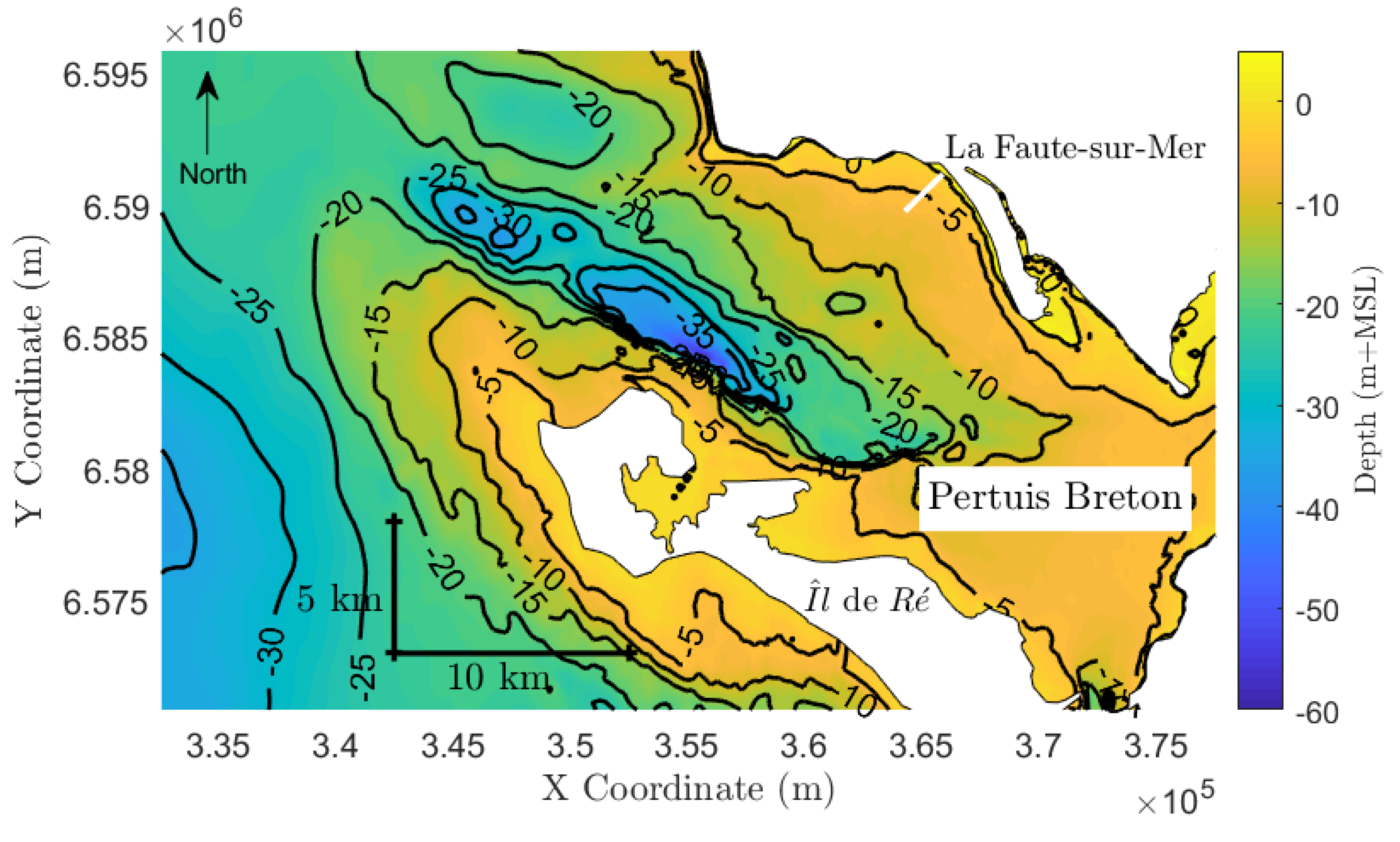
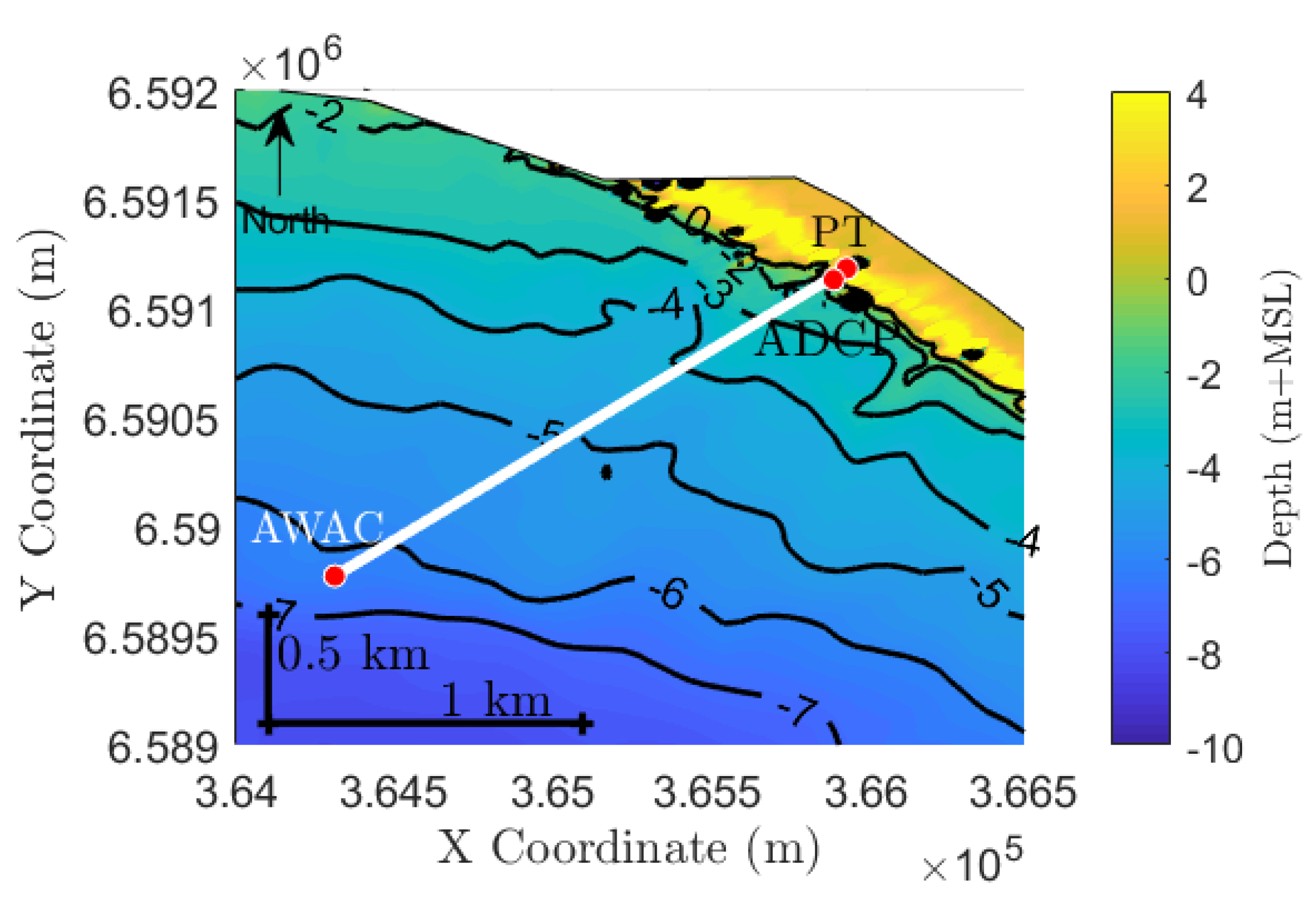
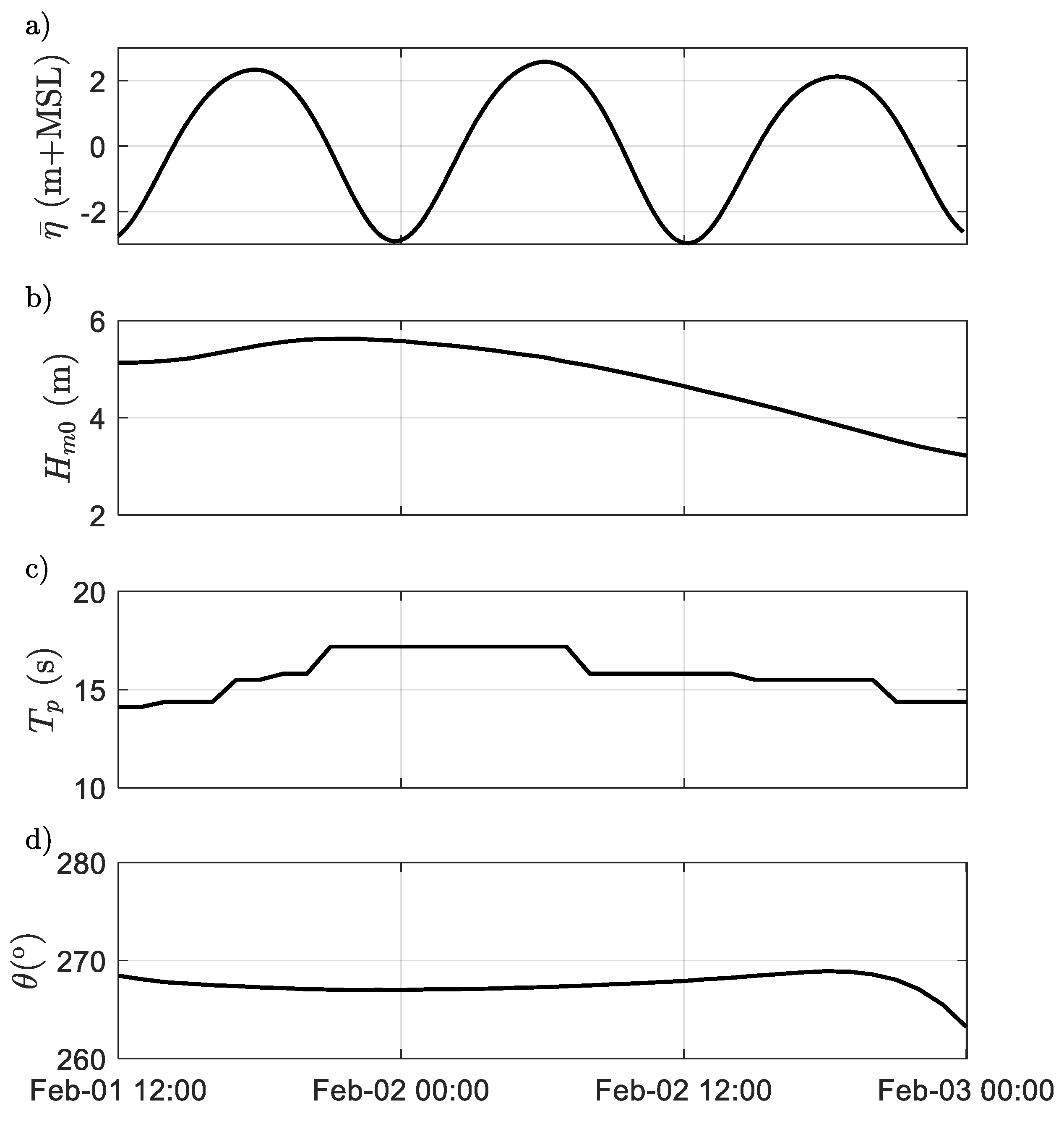
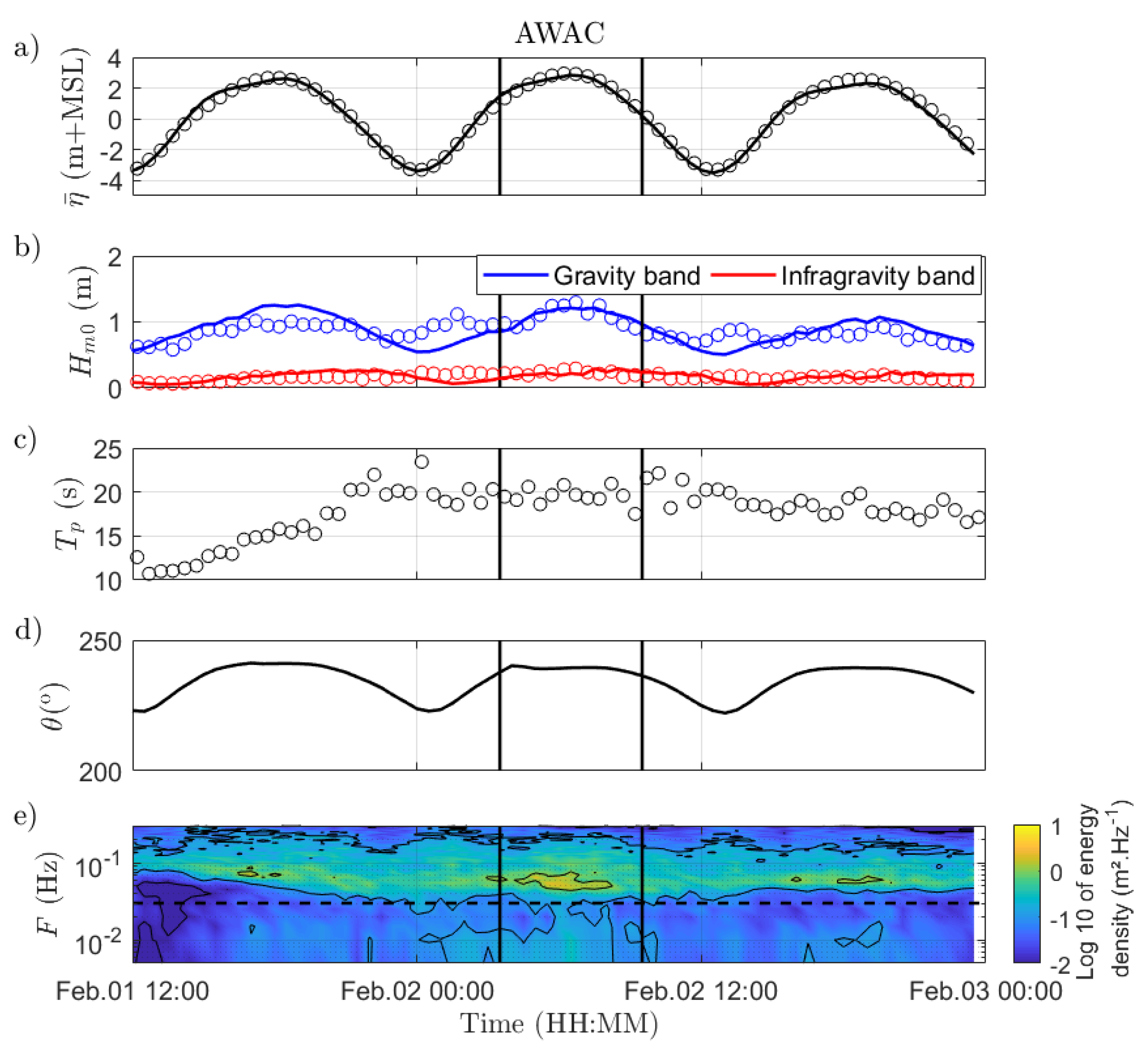
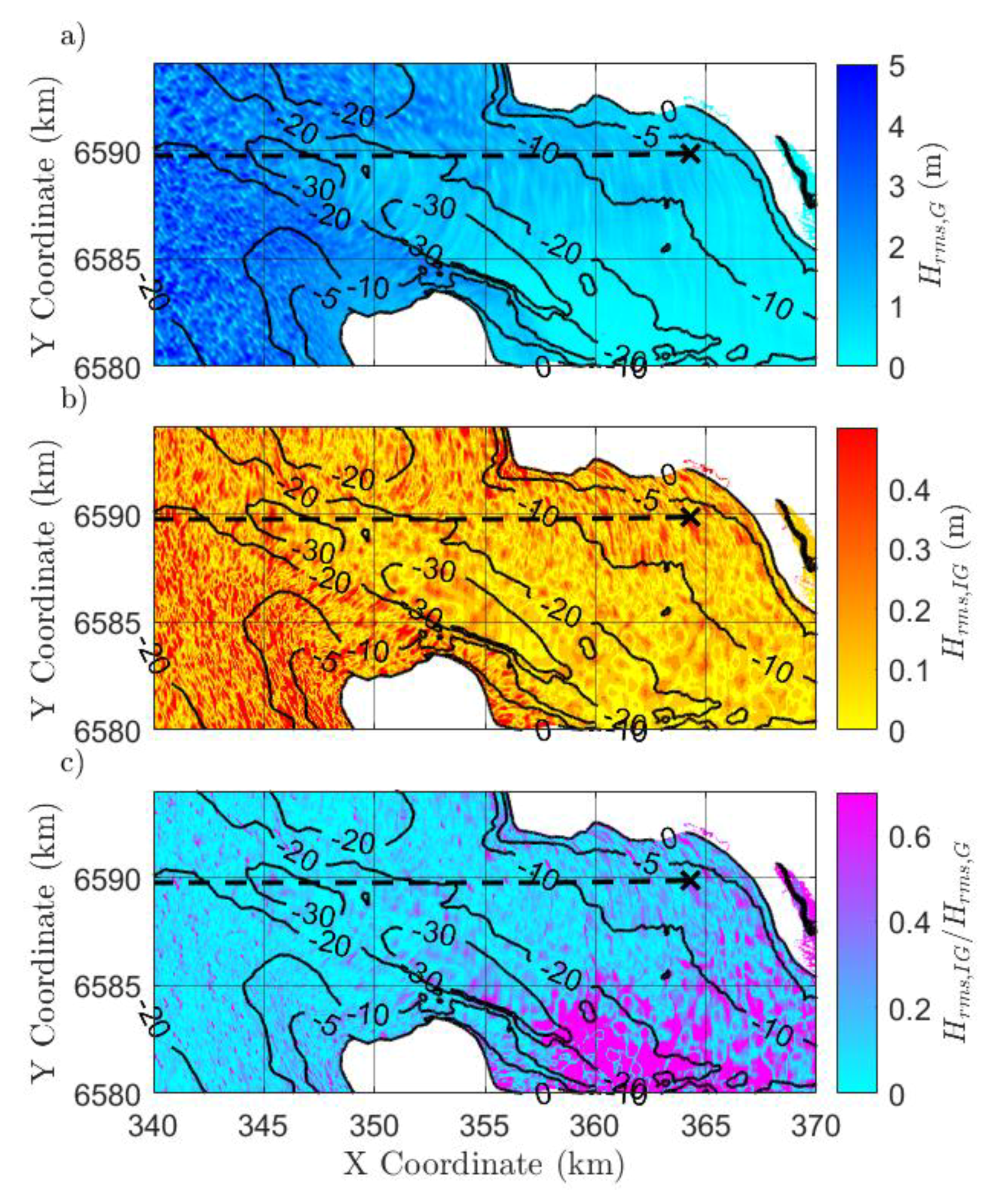
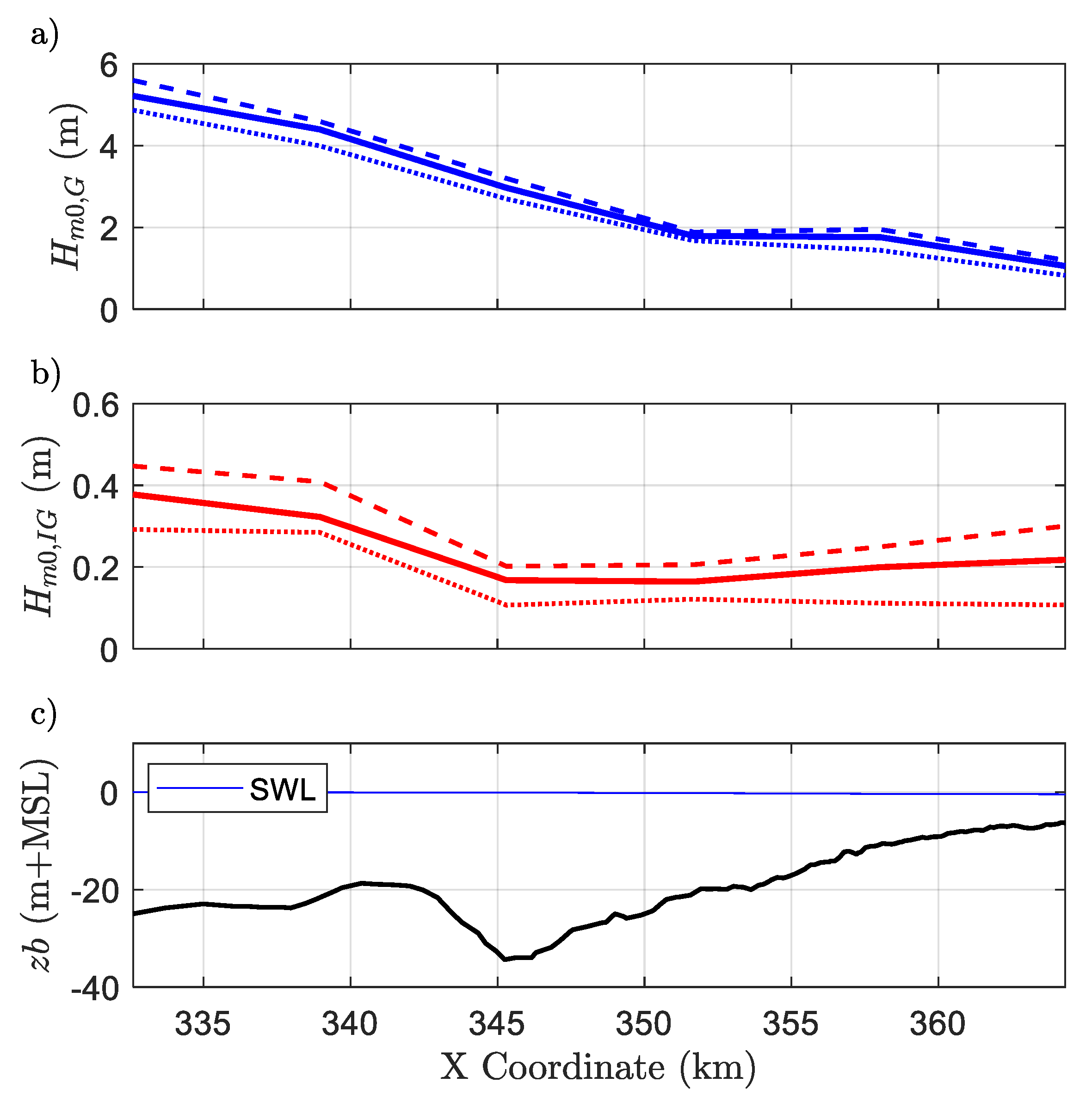
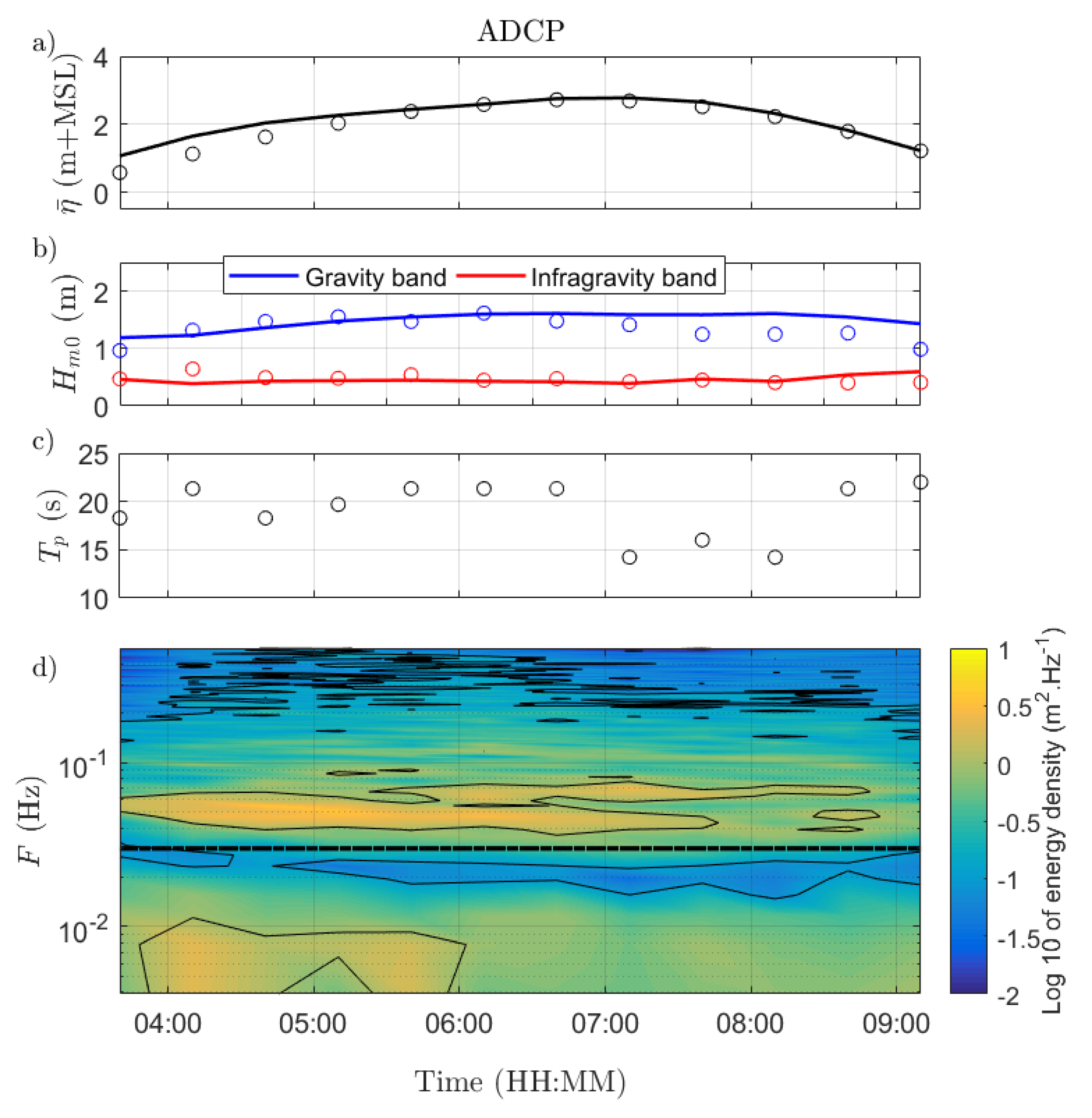
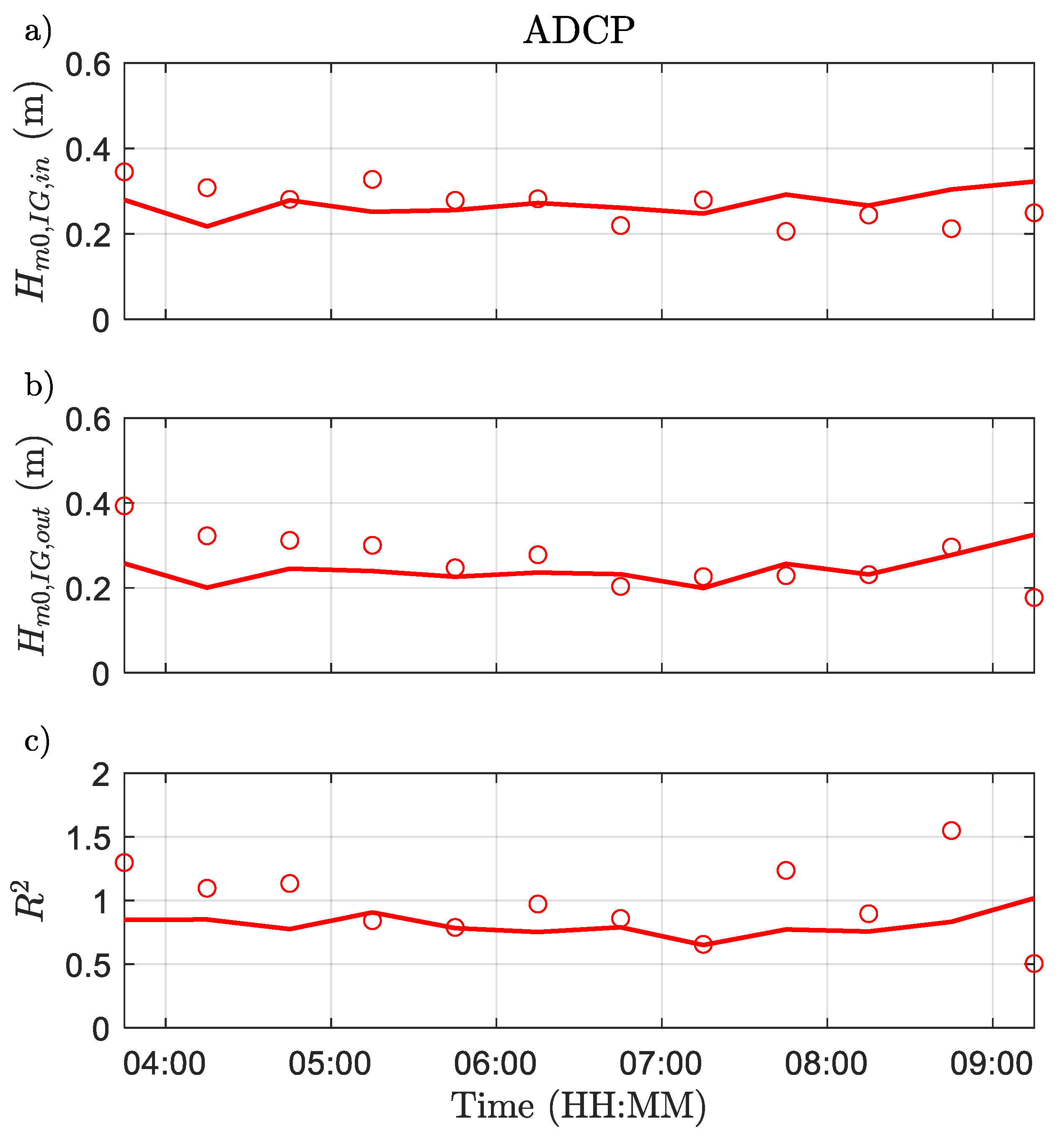
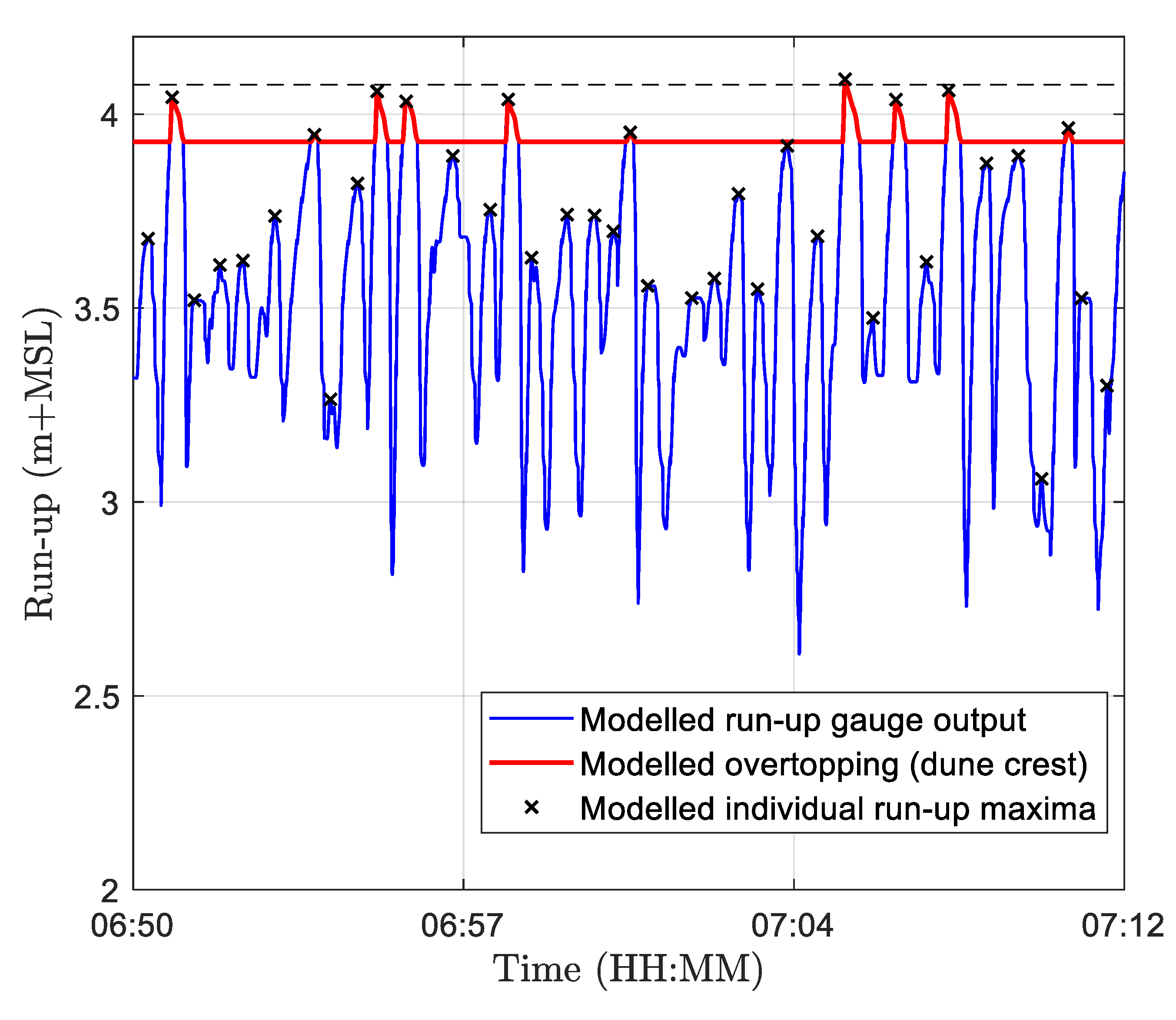
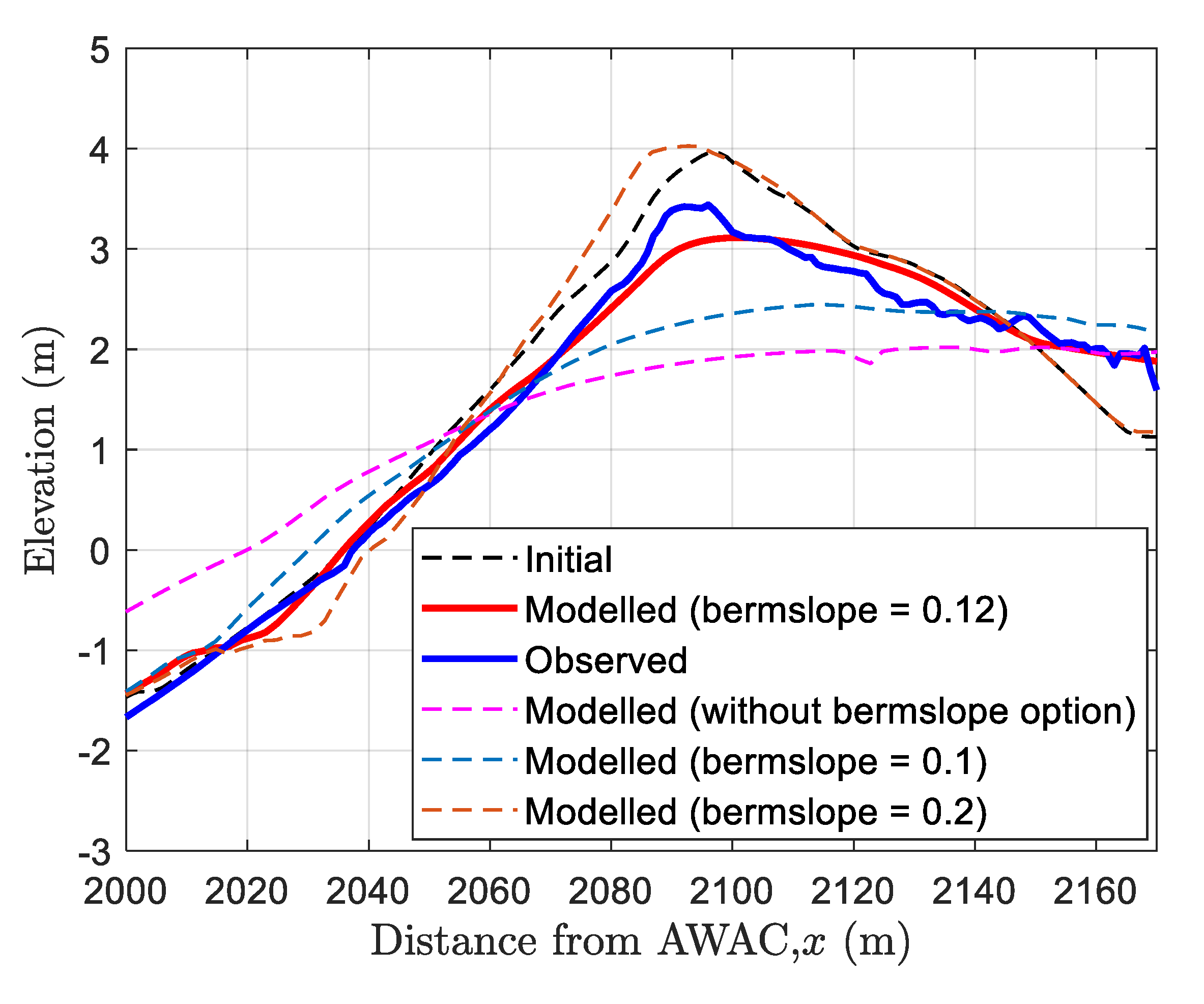

© 2019 by the authors. Licensee MDPI, Basel, Switzerland. This article is an open access article distributed under the terms and conditions of the Creative Commons Attribution (CC BY) license (http://creativecommons.org/licenses/by/4.0/).
Share and Cite
Lashley, C.H.; Bertin, X.; Roelvink, D.; Arnaud, G. Contribution of Infragravity Waves to Run-up and Overwash in the Pertuis Breton Embayment (France). J. Mar. Sci. Eng. 2019, 7, 205. https://doi.org/10.3390/jmse7070205
Lashley CH, Bertin X, Roelvink D, Arnaud G. Contribution of Infragravity Waves to Run-up and Overwash in the Pertuis Breton Embayment (France). Journal of Marine Science and Engineering. 2019; 7(7):205. https://doi.org/10.3390/jmse7070205
Chicago/Turabian StyleLashley, Christopher H., Xavier Bertin, Dano Roelvink, and Gaël Arnaud. 2019. "Contribution of Infragravity Waves to Run-up and Overwash in the Pertuis Breton Embayment (France)" Journal of Marine Science and Engineering 7, no. 7: 205. https://doi.org/10.3390/jmse7070205
APA StyleLashley, C. H., Bertin, X., Roelvink, D., & Arnaud, G. (2019). Contribution of Infragravity Waves to Run-up and Overwash in the Pertuis Breton Embayment (France). Journal of Marine Science and Engineering, 7(7), 205. https://doi.org/10.3390/jmse7070205





